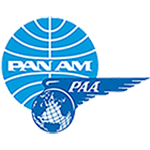APRIL 1935
"Friends Are Lost" / "Alameda to Honolulu"
“Friends Are Lost”
by Eric Hobson & PAHF
 Photo compilation: Consolidated Commodore arrival (Florida Memory) / Pan Am Commodore over Havana c. 1932 (PAHF Collection/Clyde Sunderland) / Consolidated Commodore logo 1929 (Wikimedia) /Consolidated Commodore at Dinner Key (Florida Memory).
Photo compilation: Consolidated Commodore arrival (Florida Memory) / Pan Am Commodore over Havana c. 1932 (PAHF Collection/Clyde Sunderland) / Consolidated Commodore logo 1929 (Wikimedia) /Consolidated Commodore at Dinner Key (Florida Memory).
Word raced across Pan American Airways’ Dinner Key base Tuesday, April 16, 1935 about a hanger fire: Leroy Norton, a PAA mechanic, was burned critically, David Sox broke an ankle, and Consolidated Commodore NC660M smoldered.
The fire erupted inside NC660’s hull where Norton was working. According to Associated Press reporting, his electric drill sparked fuel fumes and ignited liquid fuel seeping from a pump valve. Mr. Sox, a painter, jumped off the aircraft to escape the flames.
NC660M was the fourth of fourteen Commodores ordered by New York, Rio, and Buenos Aires Line (NYRBA) on December 18, 1929 at a $100,000 unit price. Delivered to NYRBA in April 1930 and christened, "Cuba", the aircraft passed to Pan American Airways five months later when PAA absorbed NYRBA.
NC660M spent most of its five years flying routes from Miami to Havana, Cuba, to the Lesser Antilles and on to Belem, Brazil, to Nassau, The Bahamas, and to Barranquilla, Columbia.
Until mid-1935, the Kingston to Barranquilla leg of PAA’s Miami to Cristobal, Panama route was the world’s longest flight overwater and NC660’s pilots strained to see land after hours flying above the waves. A "Who’s Who" of PAA’s first pilots shared that experience at NC660’s controls: Carl Dewey, Addison Person, “Red” Williamson, “Rod” Sullivan, Basil Rowe, “Gentleman Jack” Tilton, Charlie Lorber, Bob Fatt, “Cubby” Culbertson, “Uncle Ed” Musick, Bill Cluthe, “Shorty” Clark, “Dutch” Schultz, Leo Terletsky, “Cap” Swinson, Roy Keeler, and “Johnny” Rogerson.
Over the years of flying the Consolidated Commodores, these pilots had developed a camaraderie on their Caribbean and Latin American routes, as well as a trust and reliance on Pan Am ground crews who kept the planes in top condition for their long flights. In the difficult moment when they learned of Leroy Norton’s tragic death and David Sox's injuries from the hangar accident, these pilots were also challenged by the first loss of one of the company’s trusted Commodore fleet.
As a result, in the air and on the ground, Pan Am continued to strive and enforce the highest standards of safety and workmanship possible at that time, thanks to the ongoing efforts of Andre Priester, Chief Engineer of Pan American Airways.
“Fire Destroys Miami Airplane.” Sarasota Herald 4/16/1935, p.8.
“Leroy A. Norton a mechanic died late Tuesday…” Virginia Chronicle Daily Review, Volume 30, Number 11419, 17 April 1935, p. 1.
“Miami Arrivals, 1929-1933.” Author’s database.
“PAA Through Kingston, 1930-1934.” Author’s database.
Alameda to Honolulu
Excerpt from "PAA's Pacific Survey Flights by John L. Johnson, Jr. in "The Airpost Journal", April 1985 (used with permission).
First Survey Flight (California to Hawaii)

Pan American Air Ways, Supplement 1, 1935
Access the PDF at University of Miami Special Collections, Pan American World Airways, Inc records: https://digitalcollections.library.miami.edu/digital/collection/asm0341/id/50150/rec/25
Test flights were flown from Alameda on April 5, 9, 10 and 15.
 Sikorsky S-42 Pan American Clipper over San Francisco Bay Bridge construction 1935 (Pan Am Historical Foundation photo).
Sikorsky S-42 Pan American Clipper over San Francisco Bay Bridge construction 1935 (Pan Am Historical Foundation photo).
With the Pan Am base at Pearl Harbor in Hawaii ready, the decision was made to fly the Pacific the next day [April 16]. This would be the first of four round-trip survey flights made before the official inauguration of trans-Pacific air service to the Philippines on November 22 of the same year.
There follows data on the four flights, brought together for the first time, giving flight takeoff. landing and elapsed times, flight distances, com. position of crews, and avallable information on "official" and "unofficial' covers carried. Collectors were informed by the Post Office Department how they might obtain covers on the first and the fourth survey flights, but these were handled outside the mails by Pan American.
Information taken from flight logs show all times as local, based on the international (24) hour clock. All distance figures are in nautical miles.
The following time conversion table was in effect in 1935:

* NEXT DAY. (Note: The times then in effect in Hawali and Guam continued at least until December 1941. When they were changed to the on-the hour times now prevailing has not been determined.)

Crew: Captain Edwin C. Musick, commanding: Captain R. O. D. Sullivan, first officer; Harry R. Canaday, second officer; Victor A. Wright, third officer (engineering); William T. Jarboe, Jr., fourth officer (radio); Frederick J. Noonan, navigator. (Photo: from University of Miami Special Collections, Pan American Supplement, 1935).

Sikorsky S-42 Pan American Clipper arrival Honolulu April 17, 1935 (University of Miami Special Collections from photo negative).
E
Pan American Clipper crew in Hawaii after their epic flight from Alameda to Honolulu (University of Miami Special Collections from photo negative).
@panamhistory on instagram
Around-Island (Hawaii) flight of 5 hours, 5 mlnutes duration was flown on Apr. 19.
Upon her return to Alameda the NR-823M received additional modifications, including the installation of additional internal fuel tanks which increased her fuel capacity to 2,907 gallons.

University of Miami Special Collections, Clyde Sunderland photo.
Upon his return to Alameda, Capt. Musick stated:"Before this flight the crew had flown some 15,000 miles on the Sikorsky S-42 type Pan American Clipper under the closest possible approximations of those conditions we met on the actual flight. In those flights we had flown the Pacific so many times that the actual flight appeared to all of us as something we had done before."


